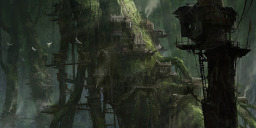
The City of Towers
The river's tent is broken: the last fingers of leaf
Clutch and sink into the wet bank. The wind
Crosses the brown land, unheard. The nymphs are departed.– T.S. Eliot, The Waste Land
Northwest of Canterlot, perched high in the boughs of an ancient oak tree, there is a city in miniature. It is a place of soaring towers and deep shadows, and its name is Keskiyönnon.
To the unicorns of nearby Vanhoover, the tree is a minor tourist attraction. Its trunk is forked where lightning struck when the tree was a sapling, more than a thousand years ago. On the east side, its branches spread over the headwaters of the Farrier River. Straight white limbs stretch toward the sunshine that dapples the water's surface. Here the tree reaches its greatest height, climbing over two hundred feet in the air and giving shade to colonies of trout and salmon who live below. On the west side, the tree's branches are gnarled and stunted, and its leaves have a sickly look.
Dawn never touches the tree's western half—the towering branches of the east cast it into darkness. At mid-afternoon, the peaks of the Unicorn Range throw early shadows across the western boughs. While the eastern half of the tree grows straight and true, the western half is a tangle of branches, each fighting the others to claim the day's few rays of light.
For centuries, the unicorns of Vanhoover have called the tree "The Oak of the Two Sisters", for reasons that hardly bear repeating. Long before then, it was known by a different name. The builders of the city named the tree Tammen Tellervo, for their mythical ancestor who first led them to it. Little else now remains of the Kainen Tellervo, the folk of Tellervo. Even their name is consigned to a few dusty scraps in the archives of the Canterlot library, neither seen nor spoken in many long years. Now, the remnants of their race are known only as the breezies.
Much like the oak itself, the city is a place of opposing halves. It bridges the center of the tree, with long avenues criss-crossing from east to west—through the straight-limbed branches that climb over the Farrier's headwaters and through the tangled boughs that writhe beneath the shadow of the mountains. If a winged traveler were to rest in the mountains' shade, perched in the canopy of Vyyhti (as the darker half of the Tammen Tellervo was once called), she might be able to discern the outer towers of Keskiyönnon in the exposed branches of Torni, the tree's lighter half. Although these towers once marked the sole entrance to the city, they—like the rest of Keskiyönnon—have fallen into ruin.
If that traveler—by dint of some magic—were able to shrink herself and enter the city, she would see much more.
In the dappled sunlight of the Torni Oak, spiraling towers soar into the air. They are woven from carefully sculpted branches, and each year they grow taller. The tops of these towers are verdant explosions, as the braided branches unwind and seek the light. In the days of the Kainen Tellervo, the towers were perhaps less wild, more restrained. Few beings remember, and they do not speak of this place.
Within any of the towers, the traveler would find airy, vaulting chambers. The ancestors of the breezies lived here, once—each tower devoted to its own family line. Tall doors, twice the height of an acorn, connect grand state rooms where relics of habitation remain in various states of decay. Black-painted ceramics show images of Tellervo and her kin. Faded scraps of tapestries still cling to some walls, depicting histories and extravagant entertainments. Nothing remains of the Kainen Tellervo’s storied leaf-art; all such works fell to dust long ago. Nor do any remnants hint at the elegant resin-work for which the inhabitants were once famous. Even in its ruined state, however, the opulence here is striking. Empty niches must once have held statues of some sort. Entire rooms seem devoted solely to allowing the occupants a view of the mountains nearby.
Passing into the tower’s base, the traveler finds herself in a small warren of cramped chambers, segmented by thick paper and unadorned but for tiny glassless windows braided into the walls. Through many of them, a gleaming silver spire can be seen, rising up through the heart of the tree. Were she keen-eyed, the traveler might notice small differences in the construction of these rooms. Wider, shorter doorways. Thicker floors. In spots, she might see the vestige of cracking murals that once adorned the walls of these rooms, completely unlike the decor seen in the rest of the tower.
Between the living towers of the ancient breezies lie roads of woven reeds. A traveler steeped in the earth pony lore of stones and structures might call these roads bridges—but no earth pony has ever seen this place. Many of the city’s roads stretch from tower to tower, ascending or descending as they go. In places they vault over one another in an endless game of leapfrog. Different roads stretch from the base of the towers down into the tangled branches of the Vyyhti Oak.
Unlike the towers, the roads are as dead as the city they inhabit. Below the tree, in the long months of summer, bulrushes grow tall along the water's edge. In the libraries of Canterlot, dusty chronicles record that the Kainen Tellervo made a science of harvesting these bulrushes—learning which were lightest, and which were sturdiest; how best to gather them, and how to braid them. They mastered the subtle magic of anchoring their reed roads to the towers as they grew, and of treating those roads so they could endure over the long years they expected their city to stand.
Few creatures remain who recall Keskiyönnon, but once its name was known in every corner of the land. The City of Towers. The Heart of the Tree. The elegant capital of the Kainen Tellervo, most graceful of all the equine races. This was the Keskiyönnon all ponies knew.
Taking one of the downward paths to the Vyyhti Oak, the traveler encounters a different city. At the border between the eastern and western halves, the tangled branches of the Vyyhti Oak struggle against the thick boughs of the Torni Oak. There is new growth here—green leaves hunting and climbing toward the light. At the same time, there is further evidence of the city’s decay. The roads of woven reed become pitted and sap-stained. Twigs constrict around them and push them askew. Even in the gentlest breeze, the branches here creak and moan. Here, the sound of a soft buzzing fills the air.
Descending into darkness, the traveler finds new structures carved from the tree itself, nothing like the towers of the Torni Oak. Hives of rough, windowless homes are hacked from the wood—single rooms with wide, empty doorframes. Reed-woven scaffolding circles these branches, tying into the chaotic network of roads that descend from the towers above.
Within the rough-hewn branch rooms, the traveler sees more faded scraps of paint, more hints of long-forgotten murals. Here, she finds housewares made from a hard, slick resin, the last relics of one of Keskiyönnon’s storied artforms. In all of the homes, a thick pulpy paper forms shelves and cabinets that remain mostly intact. Some homes are larger, with taller entryways, and these often contain shards of the same black-painted ceramics found in the Torni towers.
The traveler may notice several structures built entirely of paper as well. They are tall but cramped, and abut the wood-carved homes. These paper huts appear newer, though still ancient and disused, and most have fallen to ruin.
One reed-path, wider than the rest, leads down toward the heart of the tree, toward the spot where lightning cleaved through it long ago. Although centuries have passed since the last of the Kainen Tellervo set hoof in this place, the downward path is well tended, free of leaves and with ample space around it in the ubiquitous tangle of the Vyyhti Oak’s branches. At the end of the road sits the base of an enormous, silver spire, rising up through the canopy above.
The spire is thick at the base and tapers little as it rises. Close up, the traveler observes that the spire is formed from layer after layer of leaves. White veins stand thick on the surface of the leaves, and a transparent resin coats the entire structure, giving the spire its reflective sheen. The long years of abandonment do not seem to have touched its exterior. An enormous door, nearly the size of an apple, stands open to the air. Once, this was the heart of the city—where the rulers of the Kainen Tellervo would gather to pass laws and sit in judgment. Windows of clear resin dot its circumference and mark out sixty-two stories climbing toward the sky above.
Inside the spire, twin staircases twist upward along the walls. A single high-ceilinged atrium comprises the first floor, with a long channel rising up through the center of the tower and revealing the open sky overhead, beyond the treetop. The floor of the spire is tiled in colored stones. A hint of their long-ago polish can still be seen near the outer leaf-mat walls, but toward the center dark stains spill unevenly across them. On the opposite side of the chamber, the traveler can see another door leading out into the Torni Oak, taller and sleeker than the Vyyhti entrance.
Ascending through the spire, the lower floors are all a shambles. Some show rooms that are open to the central column, and wind has battered these over the long years since Keskiyönnon's occupation. Some show warrens of paper-walled chambers with wide entrances, not exposed to the elements, but here too are ruins. Tumbled statues to Tellervo and her parents, Mielikki and Tapio. Sturdy reed-woven furnishings overturned and broken.
Halfway up, the stairways open onto a tall, cavernous amphitheater. The spire’s central shaft is walled away here, with thin-spun resin forming a transparent cylinder at its heart. The traveler encounters benches of rough paper, torn to powder in many places. The air is still and oppressive here, carrying the feel of undisturbed centuries. At the heart of the room, encircling the central shaft, is a raised speaking platform. In some places, its surface is polished to a mirror-like shine. In others, it is scarred and pitted, stained a darker color than the rest of the wood.
The rooms in the upper half of the spire are much like those below.
At the top of the spire stands a large, circular gallery. Long display cases ring the room, crafted from clear resin and pulpy paper. Many of them are still intact. Alongside black-painted ceramics and intricate resin sculptures, the traveler at last finds the fabled leaf art of Keskiyönnen locked away from the elements.
The leaf art is reminiscent of the outer walls of the spire. Through careful cultivation, the Kainen Tellervo were able to force the veins of leaves into intricate patterns as they grew. Of the pieces on display, the majority are abstract images of boxes and whorls, crafted from the rounded leaves of magnolia and mulberry, holly and hornbeam. But along the western face of the tower, a long progression of images chronicle the history of the city. These, and only these, are written into the oak leaves of the Tammen Tellervo itself. In the first few leaves, the traveler sees simple figures approaching an enormous tree and exploring it. One of the resin cases here is broken and no hint remains of what story its artwork might have told. Further on, the images describe construction and cultivation, how the Kainen Tellervo built their towers and reed-roads. After these come images of leisure—the Kainen Tellervo resting by the banks of the river below, or admiring the sharp peaks to the west.
Some leaves in this third set show the intricate process of creating leaf art, others show resin workshops. There are odd differences between these scenes. Just as in the first sets of images, the pictures of leaf art creation use long, thin veins to sketch the bodies of the Kainen Tellervo; but the creatures in the resin workshops are depicted with short veins bunched tightly together. Continuing on to the last set of leaves, showing the construction of a tall spire at the heart of the tree, both forms now share space in the same images. There is a persistent air of hopefulness in these leaf-designs—although the figures are mere line representations, care has been taken to show them smiling.

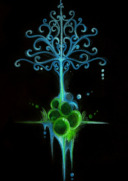


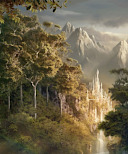

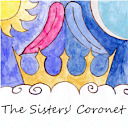


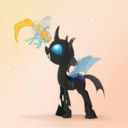
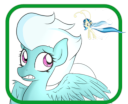



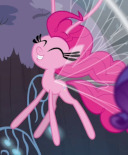


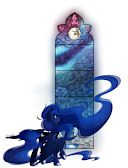





Author's Notes
This was originally an entrant in the June 2015 Writeoff, "A Matter of Perspective". The initial version can be found on the Writeoff site, and also in my "Original Versions" collection.
Although the whole Writeoff crew deserves thanks for their comments about this story, I want to single out horizon and Bad Horse in particular. Horizon brought my attention to some of the structural issues in the first version (it tried to have two climaxes); and after I realized that the original theme was painfully close to Cold in Gardez's first chapter of "Lost Cities", a discussion of the story with Bad Horse prompted the shift toward wasp-related motifs.
I also want to thank both Themaskedferret and Cold in Gardez himself, who looked over the updated version and provided comments.
This story was a real beast to put together. I was impressed with "Lost Cities" before I wrote it. After how much trouble these 2000 words gave me, I'm far more impressed with "Lost Cities" now.
"Lost Cities" is deceptively simple, by which I mean, it conceals on first glance the painstaking care with which it is written. You know it's a beautiful thing to look at, but you don't see until a repeat reading the intricate support system beneath the beautiful surface, the craftsmanship of structuring a proper narrative using implication alone. I think you've done the original justice with this one; I particularly like the closer, and the setting itself is vivid as all fsck. Congratulations!
This certainly changed from the writeoff version. That last bit has a nice, understated punch.
It's a shame most people are going to see that [Experimental] tag and not give it a chance. :\
I quite enjoyed this. It was not only a clever use of the theme, using breezies as the subject ponies, but was vivid and flowed very well.
I have to admit I'm attempting to write a Lost Cities story right now - have been for the past month, and am about 1/2 way to finishing – and it really is much more difficult than it looks, especially when you're trying hard to not emulate CiG's style, which in this story format seems pretty difficult. That well-connected flow from one idea or visual to the next is what's giving me the most trouble, though, and you handled that very well in this story.
Also: Honestly, what's with the [Experimental] tag? This is a Bradel story, and it's a good one. No need to put up a sign that asks for forgiveness in advance.
6326106
6330262
6330406
(Might as well just toss y'all on.)
About the [Experimental] tag:
I really, really, really like my upvote ratios. Like, I've got a truly unhealthy thing for them. Horizon and I were kind of talking about this a bit elsewhere. So for me, putting the [Experimental] tag on is a way of trying to make sure that people know what they're getting into, and to hopefully avoid "Oh, I hate this type of thing" downvotes. It probably makes the story marginally more niche—but I only thought to add the thing today and even before that it took about twelve hours for this thing to even make it to ten upvotes. I don't think it's ever going to be a big hit. And that's fine. If anything, putting [Experimental] in the long description feels to me like it might be more likely to attract the sort of readers that'd actually be interested in it.
But maybe I'm wrong.
About writing things like this:
Yeah, I had no idea how hard this type of thing was until I tried it. I really don't know how to express to you guys how happy I am that you're enjoying it. I got a positive reaction from Cold in Gardez, too, pre-publication (I don't know if he's noticed that it's live or not). I wanted to tear this thing up and throw it away a couple times. I'm still not totally sure how I feel about it myself, but like I think I might have said elsewhere, I don't know if I'll be able to read it for its own sake until a few more days have passed. Then I'll hopefully have a better sense of how I think I did with it.
To Southpaw, though, horizon deserves some credit for the narrative flow here. The original version still had a tour to it, but he felt (and I think correctly / I think the Writeoff shared the feeling) that it was more uneven. It hit a climax in the middle, and then another one at the end, and the middle one may have overshadowed the one at the end. His suggestion to focus on the spire as the final point of the journey was one of the two big foci in the revision.
I think the first version of this was arguably the most difficult I've ever found it to write two thousand words. And figuring out how to edit it around, what to add, what to remove, what to change—that was pretty bad too. But I'm really glad to have done it, because that sort of editing has always been a bit of a block for me. I'm hoping I'll have an easier time making significant changes to future things after struggling through this and learning at least a little bit about how to do it.
6330682 I think I read this before you put the tag in the description—kinda stumbled upon it when I first saw it posted, then came back when I saw it creep into the pop box to see how it was doing. I'll admit, this isn't really something I'd normally go for in a story, but I do love how you crafted the scenery and brought everything together. Really, it's the kind of writing that makes me just smile, shake my head, and say, "Well, there's no topping that. Back to coloring with my crayons while this guy paints on a canvas."
I'm still not certain that I'd enjoy this type of story in the future, but I can definitely appreciate the effort you put into it and how vivid you made everything. The blend with history and describing the city itself was very nice, I must say.
Welp. That may be the most beautifully written thing I have seen on this sight. Maybe seen anywhere. It was gorgeous, and it is an absolutely magnificent display of worldbuilding, and scene setting.
It just didn't feel very pony to me. Maybe it's because we have so little to go on the breezies that this could have applied to any kind of tiny fairy like race, or maybe it was the distinct names here, but the story above did not feel like it really existed in the FiM universe. I kept thinking, "This needs to be its own thing. It reads like it's its own thing." The pony references felt off, like they were trying to tie it to themselves, and not really succeeding.
That said, this does not really degrade the quality of what you have presented, not in the slightest, and I am more convinced than ever that you need to write some high fantasy novels. Time to craft a universe of your own! (Finish Bell, Book, and Candle first though? Please? )
)
6335290
Have you read Cold In Gardez's Lost Cities? If not, you'll almost certainly enjoy them.
Alright, so... I've read this a few times now, and I'm not sure if I'm missing something, or if it just isn't there at all.
I get the whole dichotomy between the two halves of the city, and that there was a civil war of some sort, with the ones from the dark half of the tree overthrowing the ones from the light half of the tree, and apparently looting the city, but was there some deeper subtext?
6337270
I have an answer to that, but I'm a little interested to see what take 6326106, 6330262, 6330406, 6334980, and 6335290 might have on it. (Also Ferret and Cold In Gardez, who have both read it but not yet shown up in the comments here.)
I definitely intended another layer past that, and I know Ferret got at least some of it, but it's never made explicit and the one place it could have been explicit (the broken case in the gallery at the top of the spire) I intentionally left it unsaid.
6337517
All I get concretely is what TD got, though the heavy wasp imagery and the ambiguously chilling last line suggests some sort of parasitism is going on (biological mind control?) I could go out on a limb (pun unintentional) and suggest that this was neither the "dark" breezies victimizing the "light" ones or the other way around, but rather some unseen third faction playing the both of them, but that's me guessing wildly. It is tempting to say that the silver spire represents the last effort of the divided species to work toward a common goal, but it is also tempting to say that the silver spire was no one's goal except a third-party puppeteer's.
6337517 Hi, again. Went back and reread it so I'd have a fresh perspective on it—been a couple days and I've been busy doing other things, so I wanted to make sure I had everything in place before I replied.
I'd honestly have to throw in with the idea of a civil war between the "light" and "dark" breezies here. As 6337270 said, the divisions between the lighter and darker sides were particularly striking. I feel like the differences between the towers and the structures carved out of the tree itself were a big hint that cultural divisions between the two—perhaps something that might've lead to the conflict and eventual fall of the city? I may be reading a bit too much into that. If so, forgive me. Different cultures are rather interesting to me, so I tend to look for stuff like that in AU fics or those dealing with experimental concepts (those that I'm able to find and read, anyway >.>).
6337632 's point is something I hadn't considered in this. I'm not sure if I'd go with the biological parasitism—but given that there is a species of wasp with a natural "zombification" type ability in Japan that I just can't remember the name of—but the idea that a third faction played the two sides against one another is a rather interesting take on it. Also, I didn't quite read the same "chilling" notion into that last line. Rather, I took it to be along the lines of a warring nation's artisans crafting hopeful imagery to give its citizens a bit of something to cling to—the notion of a happier future.
Just my take on things. I'm afraid I'm rather "Joe Schmo" on the analysis front by comparison, here, so I may have missed or misinterpreted a few things along the way. Still, glad I stumbled upon this, so good on ya.
Incidentally, my other bit of speculation was the dark ones were changelings, between the lost "resin" and their dark insectoid nature, but that doesn't make much sense given the scale of the place seems to suggest they would be far, far bigger than the scale of the place would suggest, which is why I rejected it.
I avoided other's thoughts on this before I wrote this, so... I'm likely entirely off-base here, and far off from what you're referring to, but this unfortunately isn't my strong suit. Here are my thoughts anyway.
I noticed a lot of details on the first read and filed them away as interesting differences between the east and west sides, but having re-read this, my impression now is that there weren't simply minor differences between the peoples of each side, but that they were actually different races, as there are for ponies.
To the east, we had taller, more slender beings that lived in wealth and a richness of culture and encouraged expression (reminiscent of unicorns).
To the west, we had larger creatures (reminiscent of earthponies?) which lived in cramped and more simple quarters, sometimes without even windows. This is never a happy visual for any being, especially in the context of this story where light and water are given to one side, and held back in some way from the other.
My impression overall was one of (obviously) a divided society that lived as close to slavery as it could without actually having chains, "unicorns" being the actual rulers, creatures with power and wealth, and the "earthponies" being low and low-regarded except for the skills they possessed. The "earthponies" lived in the literal shadow of those who enjoyed the sun on themselves and in their homes and daily lives.
And even though it pushes the overall feeling of "hopefulness" (in this case either obliviously or deliberately blind to the real nature of a shared problem), the last lines and the "history of the city" along the "western face of the tower" both gave me a feeling more of the old adage "history is written by the victors".
6337517
To be honest, I am somewhat worried I missed a bit here, because I have not read "Lost Cities" yet. I am wondering if perhaps my feelings on the story is somewhat coloured by that.
On the other hand, though I did wonder more than a bit what caused the city to be in the condition it's in, I felt as if that was secondary. It felt like the important thing here was the city itself. It was like how I imagine it feels to be an archeologist finding something the first time. It's almost academic, in fact. And I am simply revelling in my discovery, and the riddles it displays. Naturally, I will want to solve them, and there are clues apparent already. But for the moment, I simply want to enjoy the discovery, for discovery's sake.
6338581
Yeah, you really need to go read "Lost Cities".
I'm going to be flying around tomorrow, but hopefully I'll find a chance to toss down my own take on things after leaving a bit of time in the morning for 6330262 to weigh in if he'd like to do so.
6338612
For my part, I'm getting sort of an Eloi and Morlock feel from the physical distinctions of the two halves of the city. Maybe it's just a holdover from the original version but it screams civil war to me.
6338388
I'll second the "as close to slavery as it could without chains". Did you notice that there were Vyyhti homes inside the base of the Torni towers?
6340087
Cool. I totally got that vibe last night, thinking of the 2002 remake of The Time Machine. In that, the Eloi made their homes along the cliff faces, and the Morlocks weren't ultimately the mindless eating machines of the original - were instead more ruthless and cunning in their use of the Eloi as cattle (at least some of the Morlock, from what I recall).
I get the feeling in this story that the Torni felt and acted superior, and that as such they were entitled to the labors of the lower Vyyhti race, and otherwise cared little for them. Probably they saw nothing inherently wrong in this.
Ah, yeah I missed that, just in the first few paragraphs. And their rooms are at the bottom of the tower(s), of course.
Bradel: You reference "Within the towers" in one paragraph near the beginning (plural), but in the next we're "Passing into the tower’s base" (singular). Towers' maybe?
Okay, and now I'll now go out on a limb (sorry) and mention how this story also immediately put me in mind of Rush's The Trees. The imagery is familiar. And I will now put that thought away...
6337270
Okay, looks like it's time for me to come back with author thoughts of my own! Lots of annoying spoiler-text to follow because author self-interpretation, and (c.f. Death of the Author) I prefer to not have that openly visible to people who don't want to see it.
6338581
First off, I want to say how much I enjoyed this "interpretation". Obviously it doesn't give me a whole lot to comment on, but the idea of enjoying things for the mystery rather than trying to unravel it is pretty cool.
6340087
6341209
Apparently, I need to know my Morlocks and Eloi better.
The Morlocks and Eloi thing wasn't quite what I was going for, but it turns out it's a better fit than I thought. Well, I should say it wasn't what I was going for in the end. It was what I had in mind for a substantial part of the revision, until I settled on an idea I liked better during the last day of writing and went back and tried to push things around a little to emphasize a slightly different interpretation. I still think it's a pretty fair reading, though, especially with Southpaw's more cattle-like Eloi.
One of the big elements here are the three shared living spaces. Horizon mentioned the Vyyhti homes in the base of the Torni towers, which were a hold-over from the original version that focused much more on economic inequality. Nobody has mentioned either of the two types of Torni homes in the Vyyhti area, though.
6338050
I actually considered the changeling idea myself (something like breezie changelings), but didn't quite go that far in my head, though it's a reasonable supposition. There was a moment in writing the assembly hall scene where I had to think about it, actually. I'd wanted to use the word 'chitin' somewhere in that scene, I believe, but it's such a loaded word in the pony fandom that even a single use was going to heavily influence how people read the story. In the end, I decided that changelings were a bit too pat an answer for something that I wanted to be more intentionally obscured, and were going to add a whole host of interpretations I wasn't looking for in addition to a couple I wanted, so I didn't go that way. But this is definitely pointing in the right direction.
6337632
6337888
These get the closest to what I was intending, though at least in the way I was considering the story, there's no third faction. The Vyyhti are Skywriter's third faction. I've mentioned elsewhere that I took a lot of direction on the revision from a comment Bad Horse made to me about the Writeoff version:
That's what initially led me in the direction of Morlocks and Eloi. That, combined with the original version's hints of a civil war, and a few other pieces... left me with a jumble of thoughts and no clear plan.
I know at least one or two pre-readers criticized how much information I dropped in the leaf-art at the end, because it's so direct. There were two (possibly three) important points I felt like I needed to make there, though, that I hadn't been able to deliver elsewhere. One is just the last line—which wasn't originally the last line. I went back and forth there a little, and considered a couple one-sentence paragraphs that might have sounded a little more sinister. Eventually (and with Ferret's help), though, I decided that I liked leaving things on the "hopeful" note, precisely because of how much tonal ambiguity it leaves for the reader.
The second and third points form a pair, and no one seems to have mentioned this. Although I made sure to leave clear markers for differences between the Torni and Vyyhti inhabitants, everyone seems to have read them as "light-side" and "dark-side" breezies. That's exactly what gave me trouble for so long in the writing, and considering another option is what finally made the pieces fall together for me in the end. The leaf-art tries to make clear that the creatures living in the Torni Oak are the same as the creatures that "discovered" the tree. The creatures living in the Vyyhti Oak only appear after the broken display case.
Keeping "history is written by the victors" in mind, there are multiple ways this could be read. I think it actually jives with Morlocks and Eloi better than I'd been thinking, because it's not hard to imagine that the Torni would consider themselves to have continuity with their ancestors while the Vyyhti didn't—and after all, the Torni are the ones making the leaf-art. But the interpretation I had in mind when I wrote this was rather that the Kainen Tellervo discovered some other race already living in the Vyyhti Oak after they settled the Torni oak—a race with a number of wasp-like traits, including biological parasitism.
I tried very hard (and I hope I succeeded) in never actually stating that the Vyyhti were members of the Kainen Tellervo. I called Keskiyönnon the city of the Kainen Tellervo, I said the Kainen Tellervo were the ancestors of the breezies, and I made references to them throughout the piece—but I tried to avoid any explicit statement that the Kainen Tellervo referred to both groups. Arguably, this is a cheap misdirect on my part. To salve my ego (and because it's what I was legitimately shooting for), I'd like to think this is a case where Blue_Paladin's interpretation comes to the fore. Contemporary records probably would have only reported the Kainen Tellervo living here. The Vyyhti kept to the shadows.
It turns out that it's much harder to write a coup than a civil war. Or maybe I should call it a harvest? There are only two places in the city, I think, where violence is clearly indicated—both in the spire (and read what you will into Skywriter's suggestion of the spire's provenance there). There are a few other indications of disturbance in the spire as well—broken statues and the like. Note, though, that the only structures in the whole city described as "newer" are the cramped paper huts in the Vyyhti Oak. And that the darker half of the tree is filled with the sound of a soft buzzing.
6342781 Ah, very interesting. I hadn't considered the influence of the Morlocks and Eloi while I was reading through this, as it's been several years since reading of them. Always nice to see various works of literature playing a part in the development of various fics on the site, eh?
Thanks for replying and, of course, writing it! ^^
6342781
Always interesting to hear the writer's take on an ambiguous piece. Thank you for sharing.
6342781
Oh, huh, I did miss the Torni homes in the Vyyhti side.
Interesting, at any rate. Thanks for the additional unpacking.
6342781
Very interesting indeed.
It might be worth noting that, while I read this, I had been keeping in mind the recent chapters of JMac's "Quizzical Greystone and the Basements of Doom." Specifically, what Quiz said regarding lost cities and how they become lost. In that it is often a long process over time, rather than a sudden act. I wonder if that coloured my interpretation of the story here, and how it did so.
It's also worth noting I had actually taken the final line at face value, or at least that I thought it possible it was a legitimately hopeful line. The other possibility had not really occurred to me until Sky mentioned it . (At which point I was appropriately chilled.)
6342781 Thanks for giving us the in-depth on the story - I like that. This was not only an excellent story, but a good puzzle. Plus it's good to know I wasn't entirely off-base, even though I was too chicken to mention the Eloi and Morlocks at first. Horizon had to be brave for me.
If you're willing, would you be willing to look at my own Lost Cities effort? It's only about half-way, but mostly polished. I know where it's ultimately heading, but I want to see if story-wise and stylistically I'm heading in a good direction before I continue going much further. If not, no worries!
6344531
I'd love to... but I've got kind of a crazy busy couple of weeks at the moment, and I can't really promise I'll be able to do anything with it. I'm already thinking I'll almost certainly have to skip this month's Writeoff.
That said, go ahead and send me a link for it. If I can, I'll try to give it a look.
6345263 Thanks, Bradel, I very much appreciate that.
Honestly I have no expectations at the moment - it is after all not even finished. I also realized that I'd gotten so far and not even made it to the actual city yet, and I want to keep it relatively tight and low in word count. I'm going to do a bit of restructuring, and I'll send you a link some time this weekend. If you don't get to it, no worries at all. I'll just keep updating it in the mean time as I go.
Love it :)
However I missed the line about the broken display case. And interpreted it in two ways.
One, that the Breezies had two classes\castes. A long limbed light-sider, and a short-limbed darksider.
My other take was that the art of Leaf-weaving was mostly lost, so the early depictions are graceful and elegant, but the later depictions are compact, poorly woven and stunted. Simply because the artists didn't know how to do it properly anymore. Or perhaps the tree refused to grow as well to their commands.
Your story has some very nice mirrors of the Heartspire, which I think help the story in a 'history repeats' kind of way.
Thanks for writing this for us.
I reviewed this story!
My review can be found here.
So let's be blunt... On it's own, this would be unique, but by invoking such an esteemed patron, I have to judge it comparatively, and... Well, "Lost Cities" casts a VERY long shadow. This story doesn't escape it.
Not that you didn't do something really impressive, but it doesn't cast quite the same spell on me that Lost Cities did. I often liken these "an ode to..." stories to episodes of Penn & Teller's "Fool Me." They are the masters of magic, and it takes a lot to actually fool them. Merely playing the game (as you've done here) is still an accomplishment, but you feel just short of the source material. That's an A+ in the course, but not a sale to the publisher.
Oh right, reasons... Longer length spread the emotional impact thinner. You also brought in a lot of complex mythology that the reader has to piece together. Some of it lands, but some of it feels forced. You also relied too much on the binary nature of the tree/city. Great idea, but you doubled the difficulty in selling it to the reader emotionally. In other words, you tried to sell us two cities in a single "chapter" instead of the typical single. Bravo for the effort... seriously! But it falls just short of sticking the landing.
nice
As you said,
describing a coup is hard.Pays worthy homage to the style of the Lost Cities. Quite well executed: beautiful command of language, and interesting setting and tone. I'll revisit this sometime, probably even when I'm less tired!
This considerably better than the first time I read it (and that version was no slouch). I love that final line. :D
Okay, apparently what I thought happened was way off. My interpretation is that there's a clear class divide, with the wealthiest members of the Kainen Tellervo occupying all of the good real estate in Torni and forcing the lower classes to live in gloomy, dismal Vyyhti. The silver spire and surviving leaf art indicates that there were efforts made to reform the way the city works and make peace between the haves and have-nots, but it didn't work and something happened after the last leaf art that destroyed the culture of the Kainen Tellervo, most likely the work of some fanatic who decided that the world was better off without this civilization.
The idea of two different species and parasitic wasp behavior never crossed my mind, because I saw the hints of class warfare early on and tunnel--visioned on it for the rest of the story. Oops.
6512229
Well, the original writeoff version was written with the class warfare idea at the core. When I went into revision, though, I realized just how much that echoed the first chapter in Cold in Gardez's own "Lost Cities", and that by leaving that as the central conceit, I really wasn't providing anything new or worthwhile with this story. If I wanted to make this story worth telling alongside "Lost Cities", I needed to offer something different.
That was one of the reasons it took me so bloody long to revise this into a useful story. A few friends gave great comments in and after the writeoff that pointed me toward something I could do, but giving a story an idea transplant is a lot harder than fiddling around the edges, looking for better prose.
How do you pronounce Keskiyönnon?
8667917
Roughly "Kes-key-on-on", but with a slightly longer final 'n' sound.